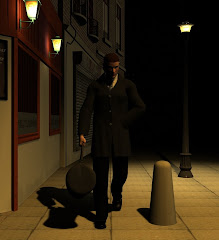
This probably isn't my favourite painting. But, outside the more demented fringes of surrealism, it has to be the one which gives me the most enjoyment. I can never look at it without raising a smile, partially patronising but mainly one of simple happiness. This is partly because of Paul Kidby's pastiche for the Terry Pratchett comic novel of the same name. But it's also because of what the original seems to show and what it really does reveal.
In a way, The Night Watch is one of Rembrandt's more constrained portraits. He was always a commercial artist dependent on patrons. In 1642 the Militia Company of Arquebusiers in Amsterdam commissioned him for a group portrait to hang on their headquarters' walls. An unflattering representation, one assumes, would have meant no cheque for Rembrandt. So he was not free to subject his models to the pitiless scrutiny he inflicted on his parents or, for that matter, himself. The Company is shown as a sturdy, impressive group of men striding out of the door and presumably to battle. Their Captain his instructing his lieutenant, the light playing over them to emphasise the red sash of one and the golden clothes of the other. The smartness of their attire would have been important to the Company. They were not just soldiers, they were declaring to the world – they were gentlemen too. In the background their troops prepare themselves; cleaning muskets, beating drums or just brandishing pikes. Even the ordering of the figures, a marvel of technical composition, had commercial considerations. Each man was given a prominence according to how much he had paid.
It was hard, though, to stop Rembrandt telling the truth. Some of his patrons were still painted with brutal objectivity; see the wizened merchant's wife Margaretha de Geer, for example. Two golden figures actually catch the eye in The Night Watch, and only one is a soldier. The other is the rather chubby young girl to the right of centre. It is generally thought that she, and the chicken which hangs from her belt, is a symbol of the company mascot. But she could just as easily be somebody's daughter who has wanders in. Regardless, her effect is to immediately undermine both the hierarchical structure and the militaristic statement of the group.
Look closer at the soldiers and these crumble further. Only the lieutenant is actually paying any attention to the captain. The rest are just getting on with their tasks as it suits them. One cleaning his rifle with a self-absorbed expression, one peering at his as if it has jammed, one raising the standard with a slow, ostentatious flourish. A few – the couple on the far right, for example – are simply gossiping. The lack of homogeneity becomes a problem too. There are one or two helmets on display, but the rank and file are almost as dandified as their officers. Some are youths, others white-bearded men. Rather than an army, this looks like a group of men playing at soldiers.
They were, of course. By the 1640's, 'militias' like the Company of Arquebusiers had lost all their original functions. Established to uphold the newly won Dutch independence, they soon became nothing but gentlemen's clubs. Pride and tradition kept them maintaining their training, their weapons and their military etiquette, but they were no more menacing than the Sealed Knot Society.
The Night Watch bears superficial resemblances to another masterpiece featuring a mass of pikes, Velasquez' The Surrender of Braga. Its meaning, though, is the exact opposite. Velasquez showed the Dutch and Spanish generals reaching an apparently amicable settlement. Yet the deportment of their respective troops shows that the former are really capitulating to the latter. What seems like peace is actually conquest. The Night Watch only came seventeen years after the events depicted but belongs to a far more optimistic era. Peace and prosperity had finally come to the Netherlands after their grim, protracted independence war. Rembrandt shows both erupting in what is supposed to be a statement of military might. This is what always makes me smile. That the men shown have reached a place comfortable enough to let them mess about a bit.

No comments:
Post a Comment